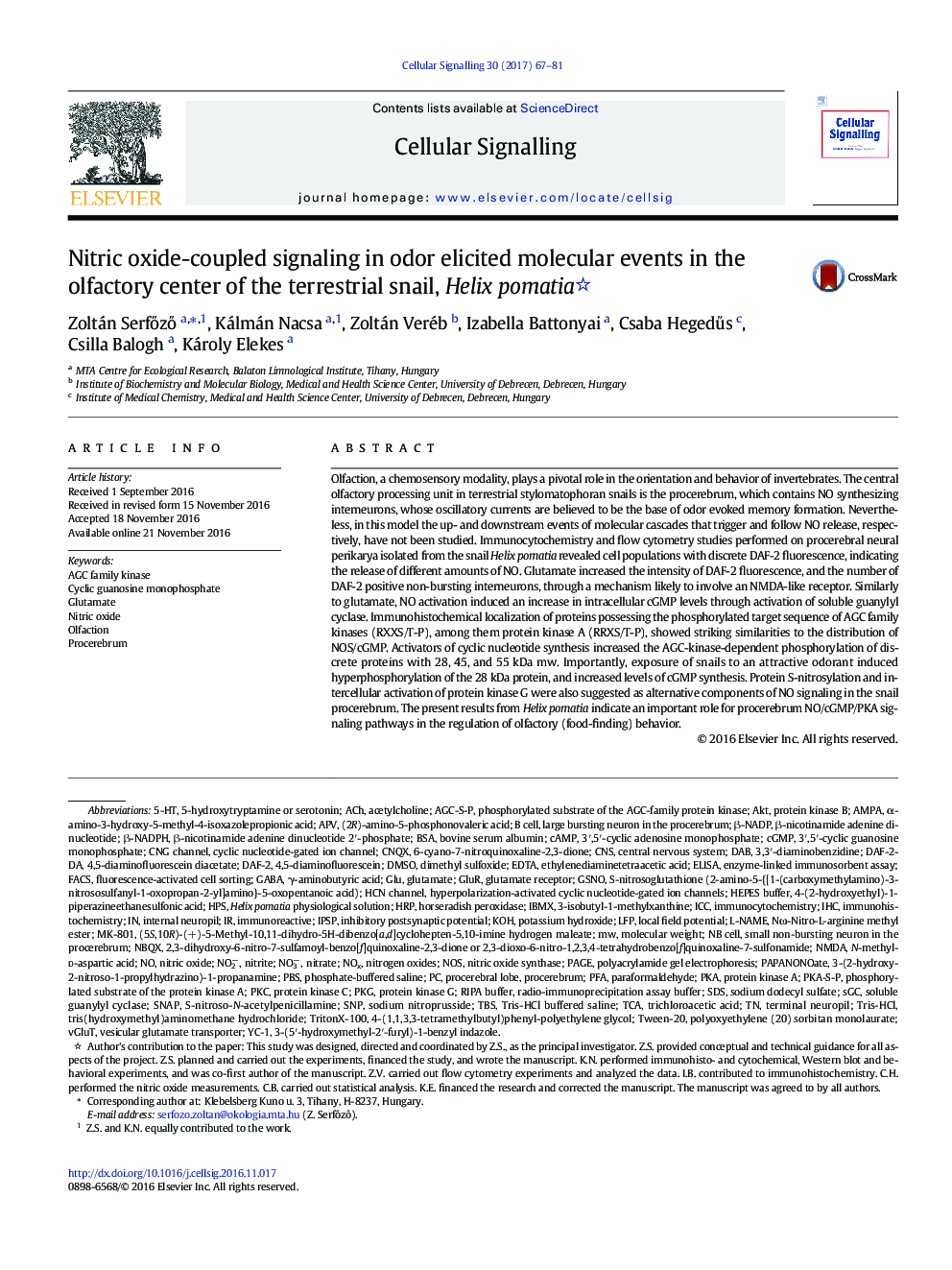| Article ID | Journal | Published Year | Pages | File Type |
|---|---|---|---|---|
| 5509435 | Cellular Signalling | 2017 | 15 Pages |
Abstract
Olfaction, a chemosensory modality, plays a pivotal role in the orientation and behavior of invertebrates. The central olfactory processing unit in terrestrial stylomatophoran snails is the procerebrum, which contains NO synthesizing interneurons, whose oscillatory currents are believed to be the base of odor evoked memory formation. Nevertheless, in this model the up- and downstream events of molecular cascades that trigger and follow NO release, respectively, have not been studied. Immunocytochemistry and flow cytometry studies performed on procerebral neural perikarya isolated from the snail Helix pomatia revealed cell populations with discrete DAF-2 fluorescence, indicating the release of different amounts of NO. Glutamate increased the intensity of DAF-2 fluorescence, and the number of DAF-2 positive non-bursting interneurons, through a mechanism likely to involve an NMDA-like receptor. Similarly to glutamate, NO activation induced an increase in intracellular cGMP levels through activation of soluble guanylyl cyclase. Immunohistochemical localization of proteins possessing the phosphorylated target sequence of AGC family kinases (RXXS/T-P), among them protein kinase A (RRXS/T-P), showed striking similarities to the distribution of NOS/cGMP. Activators of cyclic nucleotide synthesis increased the AGC-kinase-dependent phosphorylation of discrete proteins with 28, 45, and 55 kDa mw. Importantly, exposure of snails to an attractive odorant induced hyperphosphorylation of the 28 kDa protein, and increased levels of cGMP synthesis. Protein S-nitrosylation and intercellular activation of protein kinase G were also suggested as alternative components of NO signaling in the snail procerebrum. The present results from Helix pomatia indicate an important role for procerebrum NO/cGMP/PKA signaling pathways in the regulation of olfactory (food-finding) behavior.
Keywords
5-HTDABPBSFACSIBMXSDSICCTCATBSHRPcGMPNOSPAGEAMPApKaPFANMDAAPVMK-801LFPPKCGluRNBQXradio-immunoprecipitation assay bufferIPSPN-methyl-d-aspartic acidGSNOPKGHPSSGCVGLUTKOHYC-1DAF-2Tween-20HEPES bufferTritonX-100ProcerebrumS-nitroso-N-acetylpenicillamineβ-NADPHβ-nicotinamide adenine dinucleotide 2′-phosphateTris-HCl buffered saline(2R)-amino-5-phosphonovaleric acid3′,5′-cyclic adenosine monophosphate3′,5′-cyclic guanosine monophosphate3-isobutyl-1-methylxanthine3,3′-diaminobenzidine4-(2-hydroxyethyl)-1-piperazineethanesulfonic acid4,5-diaminofluorescein diacetate4,5-diaminofluorescein5-hydroxytryptamine or serotonin6-Cyano-7-nitroquinoxaline-2,3-dioneBSAcAMPDMSOl-NAMENω-nitro-l-arginine methyl esterNO2−NO3−NOxβ-nicotinamide adenine dinucleotidebovine serum albuminAChAktEDTAEthylenediaminetetraacetic acidAcetylcholineα-amino-3-hydroxy-5-methyl-4-isoxazolepropionic acidγ-aminobutyric acidtrichloroacetic acidpolyacrylamide gel electrophoresisNitrogen oxidesimmunoreactiveImmunocytochemistryImmunohistochemistryIHCRIPA bufferolfactionTris(hydroxymethyl)aminomethane hydrochlorideTris-HClELISAEnzyme-linked immunosorbent assaySoluble guanylyl cyclasevesicular glutamate transporterfluorescence-activated cell sortingCNSDimethyl sulfoxidesodium dodecyl sulfateCNQXcentral nervous systemSNAPB cellPhosphate-buffered salinecyclic guanosine monophosphatesodium nitroprussideNitric oxidenitric oxide synthaseMolecular weightparaformaldehydePotassium Hydroxidelocal field potentialinhibitory postsynaptic potentialHorseradish peroxidaseprotein kinase Aprotein kinase Bprotein kinase GProtein kinase CSNPCNG channelHCN channelcyclic nucleotide-gated ion channelGABAGluglutamateGlutamate receptor
Related Topics
Life Sciences
Biochemistry, Genetics and Molecular Biology
Biochemistry
Authors
Zoltán SerfÅzÅ, Kálmán Nacsa, Zoltán Veréb, Izabella Battonyai, Csaba Hegedűs, Csilla Balogh, Károly Elekes,
